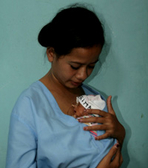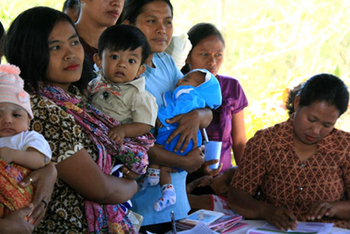Australian Indonesian Partnership for Maternal and Neo-maternal Health (AIPMNH)
Project description
Title: Australian-Indonesian Partnership for Maternal and Neonatal Health (AIPMNH)
Commissioned by: Australian Agency for International Development (AusAID)
Country: Indonesia
Lead executing agency: Indonesian Ministry of Health (MoH)
Overall term: 2009 to 2013

Context
More than 350,000 women worldwide die annually from complications during pregnancy or childbirth. 99% of these women live in developing countries. Within Southeast Asia, the highest mortality rate among mothers and newly born babies is found in Indonesia. Particularly in the poor provinces of eastern Indonesia, rates are getting worse. In Nusa Tenggara Timur (NTT), for instance, the mortality rate is 306 women per 100,000 deliveries, one of the highest in the country. Just a few of the factors causing the mortality rates to rise include a shortage of properly qualified medical staff, haemorrhaging during childbirth, blood poisoning, unsafe abortion, obstructed labour or hypertensive diseases of pregnancy. Most of these deaths would be preventable, given access to better reproductive health services, equipment and supplies, and skilled healthcare workers.
Objective
The capacity of the public health administration has improved in selected provinces and districts of Nusa Tenggara Timur.

Approach
In support of the Indonesian Government's efforts to improve maternal and neonatal health services, the Australian Agency for International Development (AusAID) is funding the Australian-Indonesian Partnership for Maternal and Neonatal Health (AIPMNH). The partnership is helping the government achieve its MDG targets by implementing a strategy, known by its local name “Revolusi KIA”, to improve the medical treatment given to mothers and newborn babies. AIPMNH provides assistance to provincial and district governments and a number of other organisations, in the following areas:
- Operational planning, budgeting, management and reporting on performance and financial expenditure
- Technical support for HR development, communications, clinical services, monitoring and evaluation of performance, draft legislation, budgeting, planning and management.
Results achieved so far
- 75% of women and newborn babies suffering complications now receive appropriate medical care.
- The use of contraceptives is becoming more prevalent.
- Service providers and communities now possess the necessary resources, skills, technical support and infrastructure to improve the standard of their service delivery.
- Government institutions now explicitly link the allocation of resources (budgeting) to annual performance targets. Furthermore, they are reliable and transparent in reporting their results to the communities, donors and the parliament.